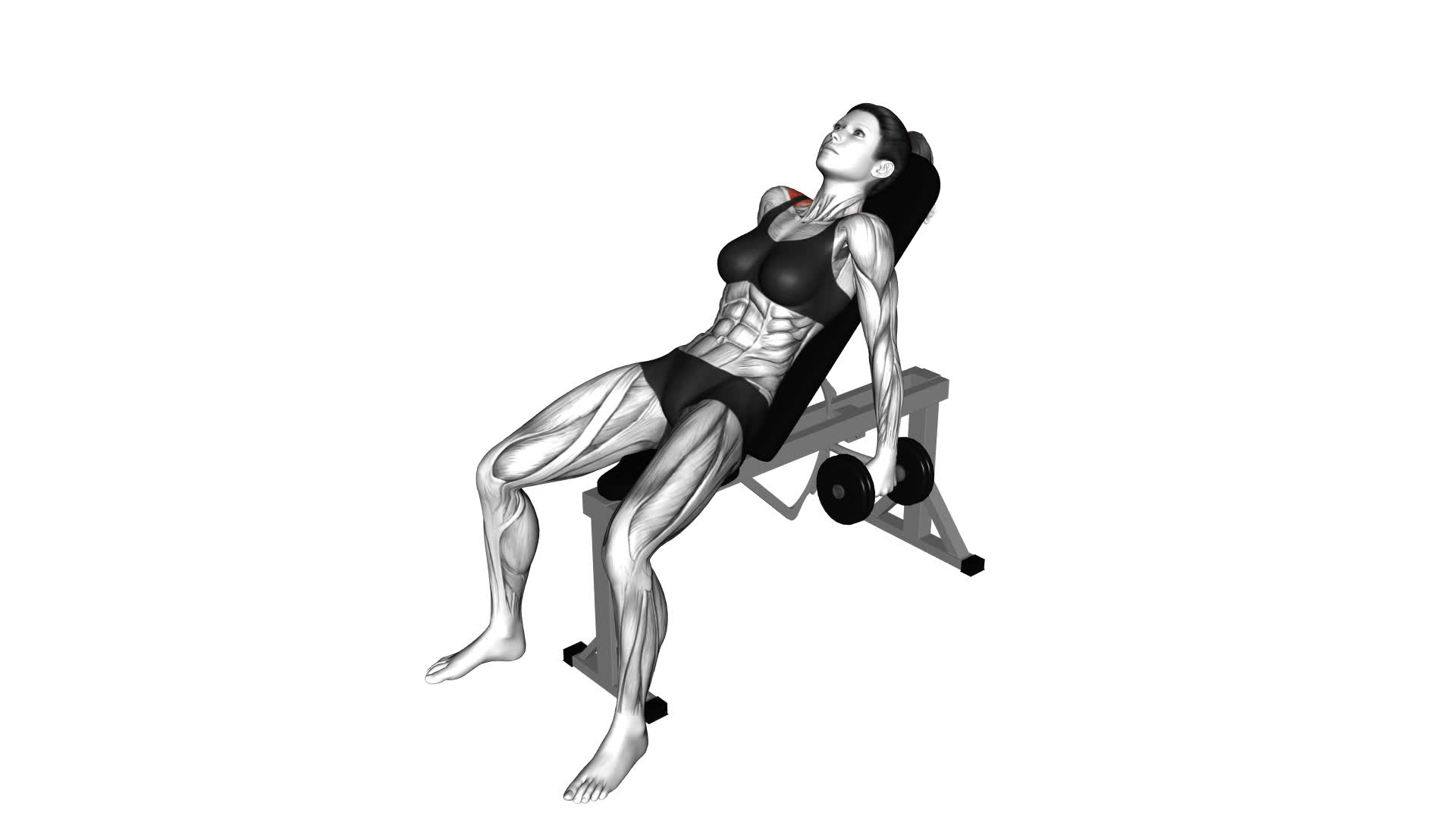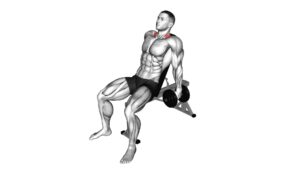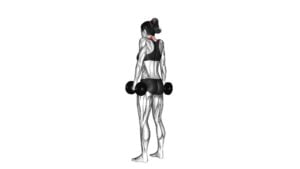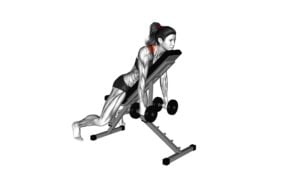Dumbbell Incline Shrug (female) – Video Exercise Guide & Tips

Are you looking to tone your shoulder muscles and improve your upper body strength? Look no further than the dumbbell incline shrug.
Watch This Exercise Video
In this video exercise guide, we'll show you the proper form and technique, as well as variations and modifications for different fitness levels.
Avoid common mistakes and get the most out of your workout with our helpful tips.
Get ready to feel the burn and achieve your fitness goals with this effective exercise.
Key Takeaways
- The Dumbbell Incline Shrug targets multiple muscles in the upper back and shoulders.
- Proper form and technique are crucial to engage and strengthen specific muscle groups.
- Strengthening upper back and shoulder muscles improves posture and reduces the risk of injuries.
- Incorporating compound exercises into the routine helps burn more calories and fat.
Benefits of the Dumbbell Incline Shrug
One of the key benefits of performing the dumbbell incline shrug is that it targets multiple muscles in your upper back and shoulders, helping to improve your posture and increase upper body strength.
This exercise specifically targets the trapezius and rhomboid muscles, which are responsible for retracting and stabilizing the shoulder blades. By strengthening these muscles, you can improve your overall posture and reduce the risk of developing shoulder and upper back pain.
Additionally, the dumbbell incline shrug also engages the deltoids, which are the muscles responsible for raising and rotating the arms. By targeting these muscles, you can increase your upper body strength, which is important for performing everyday activities and other exercises that involve pushing or pulling movements.
The dumbbell incline shrug is a versatile exercise that can be performed with different weights and variations to suit your fitness level and goals.
Now that we understand the benefits of this exercise, let's move on to the equipment needed to perform it effectively.
Equipment Needed for the Exercise
To perform the dumbbell incline shrug effectively, you'll need a set of dumbbells. The dumbbells should be of a weight that challenges you but still allows you to maintain proper form throughout the exercise. It's recommended to start with a lighter weight and gradually increase as you progress.
The incline bench is another piece of equipment required for this exercise. This bench should be set at an angle of around 45 degrees to provide the proper incline for the movement. Additionally, it's important to ensure that the bench is stable and secure before starting the exercise.
If you don't have access to dumbbells or an incline bench, there are exercise modifications and alternative equipment that you can use. Instead of dumbbells, you can use resistance bands or kettlebells to perform the exercise. These alternatives will still target the same muscle groups and provide a similar workout.
If you don't have an incline bench, you can use a stability ball or an adjustable weight bench set to a lower incline. These alternatives will help you achieve the desired incline position and allow you to perform the dumbbell incline shrug effectively.
Remember to always prioritize safety and proper form when performing any exercise.
Proper Form and Technique
To execute the dumbbell incline shrug with proper form and technique, position yourself on the incline bench at a 45-degree angle. This exercise primarily targets the upper trapezius muscles, helping to improve their strength and endurance. Proper form and technique are crucial for maximizing the benefits of this exercise and preventing injury.
First, firmly grip a pair of dumbbells with an overhand grip and extend your arms straight down towards the floor. Keep your back straight and your shoulders relaxed throughout the movement. Begin by retracting your shoulder blades and lifting them towards your ears, squeezing your traps at the top of the movement. Hold this position for a second, then slowly lower the dumbbells back down to the starting position.
Maintaining proper form and technique during the dumbbell incline shrug is essential. By doing so, you ensure that the target muscles are effectively engaged, leading to increased muscle strength and development. Additionally, proper form helps to minimize the risk of injury by placing less strain on the surrounding joints and muscles.
Remember to start with lighter weights and gradually increase the load as you become more comfortable with the exercise. Focus on performing the movement in a controlled manner, emphasizing the contraction of the upper trapezius muscles at the top of the movement. By prioritizing proper form and technique, you can maximize the benefits of the dumbbell incline shrug while minimizing the risk of injury.
Variations and Modifications for Different Fitness Levels
To adapt the dumbbell incline shrug to different fitness levels, you can adjust the weight, repetitions, or range of motion. Progression options for this exercise include gradually increasing the weight of the dumbbells as your strength improves. You can also increase the number of repetitions you perform in each set or increase the range of motion by shrugging your shoulders higher. These modifications will challenge your muscles and help you progress in your fitness journey.
For beginners or those with limited upper body strength, it's recommended to start with lighter weights and focus on mastering proper form and technique before increasing the weight. As you become more comfortable and stronger, you can gradually increase the weight and intensity of the exercise.
If the dumbbell incline shrug is too challenging or you're unable to perform it due to physical limitations, there are alternative exercises that target the same muscle groups. Some alternatives include the barbell shrug, cable shrug, or machine shrug. These exercises can provide a similar workout for your upper back and shoulders.
Now that you understand the variations and modifications for different fitness levels, let's move on to the next section to learn about common mistakes to avoid when performing the dumbbell incline shrug.
Common Mistakes to Avoid
One common mistake to avoid when performing the dumbbell incline shrug is using improper form. Using improper form not only decreases the effectiveness of the exercise but also increases the risk of injury. To avoid injury and maximize results, it's important to maintain proper form throughout the exercise.
One mistake to avoid is lifting the weights too high. When performing the dumbbell incline shrug, it's important to lift the weights only to shoulder height. Lifting the weights too high can put unnecessary strain on the neck and shoulders, increasing the risk of injury.
Another common mistake is using too much weight. It's important to choose a weight that allows you to perform the exercise with proper form and control. Using too much weight can compromise your form and increase the risk of injury.
Additionally, avoid using momentum to lift the weights. The incline shrug is a controlled exercise that targets the upper back and shoulder muscles. Using momentum to lift the weights takes the focus away from these muscles and reduces the effectiveness of the exercise.
Tips for Getting the Most Out of Your Workout
Make sure you're maximizing your workout by following these tips.
To get the most out of your workout and maximize your results, it's important to focus on workout efficiency.
First, make sure to warm up properly before starting your workout. This helps to increase blood flow, loosen up your muscles, and prevent injuries.
Next, incorporate compound exercises into your routine. These exercises work multiple muscle groups at the same time, allowing you to maximize your workout in less time.
Additionally, pay attention to your rest periods. Keep them short and intense to keep your heart rate up and maintain the intensity of your workout.
Another tip is to vary your workouts. Your body adapts to repetitive movements, so switching things up can help you avoid plateaus and continue making progress.
Lastly, don't forget to fuel your body properly. Eat a balanced diet with adequate protein, carbohydrates, and healthy fats to support your workouts and aid in recovery.
Frequently Asked Questions
How Many Sets and Reps Should I Do for the Dumbbell Incline Shrug?
For the dumbbell incline shrug, it's important to know how many sets and reps to do. This exercise is great for building upper back strength and has variations you can try.
To get the most out of it, aim for 3-4 sets of 8-12 reps. This will help you build muscle and improve your posture. Remember to start with a weight that challenges you but allows you to maintain proper form.
Can the Dumbbell Incline Shrug Help in Reducing Shoulder Pain?
Yes, the dumbbell incline shrug can be used for muscle building in addition to reducing shoulder pain. This exercise targets the upper trapezius muscles and helps strengthen and stabilize the shoulders.
However, there are alternative exercises that can also help reduce shoulder pain. For example, the standing cable row or the seated dumbbell external rotation can be effective options.
It's important to consult with a professional to determine the best exercises for your specific needs. They can assess your condition and provide guidance on the most suitable exercises to address your shoulder pain and improve muscle strength.
Is the Dumbbell Incline Shrug Suitable for Beginners?
The dumbbell incline shrug is a great exercise for beginners looking to work their shoulders. It can be an alternative shoulder exercise for those who are just starting out.
To ensure proper form, keep your back straight and pull your shoulders back as you lift the dumbbells. Remember to start with light weights and gradually increase as you gain strength.
Always consult with a fitness professional for personalized guidance.
Can the Dumbbell Incline Shrug Be Performed With Kettlebells Instead of Dumbbells?
Yes, you can substitute kettlebells for dumbbells when performing the dumbbell incline shrug.
The benefits of the dumbbell incline shrug include targeting your upper back and shoulders, improving posture, and strengthening your grip.
By using kettlebells, you can still achieve these benefits while adding an element of instability to the exercise.
Just make sure to choose an appropriate weight and maintain proper form throughout the movement.
Are There Any Specific Breathing Techniques to Follow While Performing the Dumbbell Incline Shrug?
When performing the incline shrug, it's important to focus on your breathing techniques. By inhaling deeply before lifting the dumbbells, you can engage your core and stabilize your body. As you lift the weights, exhale slowly and control the movement. This controlled breathing helps to increase oxygen flow and can enhance your overall performance.
The incline shrug also offers benefits such as strengthening your upper back and shoulders, improving posture, and increasing grip strength.
Conclusion
In conclusion, the dumbbell incline shrug is a highly beneficial exercise that targets the upper traps and strengthens the shoulders and back. By using proper form and technique, individuals can maximize the effectiveness of this exercise.
It's important to choose the appropriate weight and modify the exercise as needed for different fitness levels. Avoiding common mistakes and following the tips provided will help individuals get the most out of their workout and achieve their fitness goals.

Author
Years ago, the spark of my life’s passion ignited in my mind the moment I stepped into the local gym for the first time. The inaugural bead of perspiration, the initial endeavor, the very first surge of endorphins, and a sense of pride that washed over me post-workout marked the beginning of my deep-seated interest in strength sports, fitness, and sports nutrition. This very curiosity blossomed rapidly into a profound fascination, propelling me to earn a Master’s degree in Physical Education from the Academy of Physical Education in Krakow, followed by a Sports Manager diploma from the Jagiellonian University. My journey of growth led me to gain more specialized qualifications, such as being a certified personal trainer with a focus on sports dietetics, a lifeguard, and an instructor for wellness and corrective gymnastics. Theoretical knowledge paired seamlessly with practical experience, reinforcing my belief that the transformation of individuals under my guidance was also a reflection of my personal growth. This belief holds true even today. Each day, I strive to push the boundaries and explore new realms. These realms gently elevate me to greater heights. The unique combination of passion for my field and the continuous quest for growth fuels my drive to break new ground.







